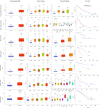Long Non-Coding RNA AGAP2-AS1: A Comprehensive Overview on Its Biological Functions and Clinical Significances in Human Cancers
- PMID: 39124865
- PMCID: PMC11314102
- DOI: 10.3390/molecules29153461
Long Non-Coding RNA AGAP2-AS1: A Comprehensive Overview on Its Biological Functions and Clinical Significances in Human Cancers
Abstract
Long non-coding RNAs (lncRNAs) are well known for their oncogenic or anti-oncogenic roles in cancer development. AGAP2-AS1, a new lncRNA, has been extensively demonstrated as an oncogenic lncRNA in various cancers. Abundant experimental results have proved the aberrantly high level of AGAP2-AS1 in a great number of malignancies, such as glioma, colorectal, lung, ovarian, prostate, breast, cholangiocarcinoma, bladder, colon and pancreatic cancers. Importantly, the biological functions of AGAP2-AS1 have been extensively demonstrated. It could promote the proliferation, migration and invasion of cancer cells. Simultaneously, the clinical significances of AGAP2-AS1 were also illustrated. AGAP2-AS1 was exceptionally overexpressed in various cancer tissues. Clinical studies disclosed that the abnormal overexpression of AGAP2-AS1 was tightly connected with overall survival (OS), lymph nodes metastasis (LNM), clinical stage, tumor infiltration, high histological grade (HG), serous subtype and PFI times. However, to date, the biological actions and clinical significances of AGAP2-AS1 have not been systematically reviewed in human cancers. In the present review, the authors overviewed the biological actions, potential mechanisms and clinical features of AGAP2-AS1 according to the previous studies. In summary, AGAP2-AS1, as a vital oncogenic gene, is a promising biomarker and potential target for carcinoma prognosis and therapy.
Keywords: AGAP2-AS1; biological function; clinicopathological character; mechanism; oncogene.
Conflict of interest statement
The authors declare no conflicts of interest.
Figures




Similar articles
-
Long non-coding RNA AGAP2-AS1, functioning as a competitive endogenous RNA, upregulates ANXA11 expression by sponging miR-16-5p and promotes proliferation and metastasis in hepatocellular carcinoma.J Exp Clin Cancer Res. 2019 May 14;38(1):194. doi: 10.1186/s13046-019-1188-x. J Exp Clin Cancer Res. 2019. Retraction in: J Exp Clin Cancer Res. 2022 Nov 2;41(1):317. doi: 10.1186/s13046-022-02521-z. PMID: 31088485 Free PMC article. Retracted.
-
Long non-coding RNA AGAP2-AS1 exerts oncogenic properties in glioblastoma by epigenetically silencing TFPI2 through EZH2 and LSD1.Aging (Albany NY). 2019 Jun 11;11(11):3811-3823. doi: 10.18632/aging.102018. Aging (Albany NY). 2019. PMID: 31186379 Free PMC article.
-
The Long Non-Coding RNA (lncRNA) AGAP2-AS1 is Upregulated in Ovarian Carcinoma and Negatively Regulates lncRNA MEG3.Med Sci Monit. 2019 Jun 24;25:4699-4704. doi: 10.12659/MSM.914766. Med Sci Monit. 2019. PMID: 31233485 Free PMC article.
-
AGAP2-AS1: An Indispensable lncRNA in Tumors.Mini Rev Med Chem. 2023;23(3):336-342. doi: 10.2174/1389557522666220615154227. Mini Rev Med Chem. 2023. PMID: 35708074 Review.
-
The role of long non-coding RNA AFAP1-AS1 in human malignant tumors.Pathol Res Pract. 2018 Oct;214(10):1524-1531. doi: 10.1016/j.prp.2018.08.014. Epub 2018 Aug 20. Pathol Res Pract. 2018. PMID: 30173945 Review.
Cited by
-
Exosomes containing long non-coding RNA AGAP2-AS1 promote the differentiation of CD4+ T cells through the miR-424-5p/SGK1 axis in psoriasis.Front Genet. 2025 May 30;16:1521470. doi: 10.3389/fgene.2025.1521470. eCollection 2025. Front Genet. 2025. PMID: 40520230 Free PMC article.
References
-
- Zhao W., An Y., Liang Y., Xie X.W. Role of HOTAIR long noncoding RNA in metastatic progression of lung cancer. Eur. Rev. Med. Pharmacol. Sci. 2014;18:1930–1936. - PubMed
Publication types
MeSH terms
Substances
Grants and funding
LinkOut - more resources
Full Text Sources
Medical

